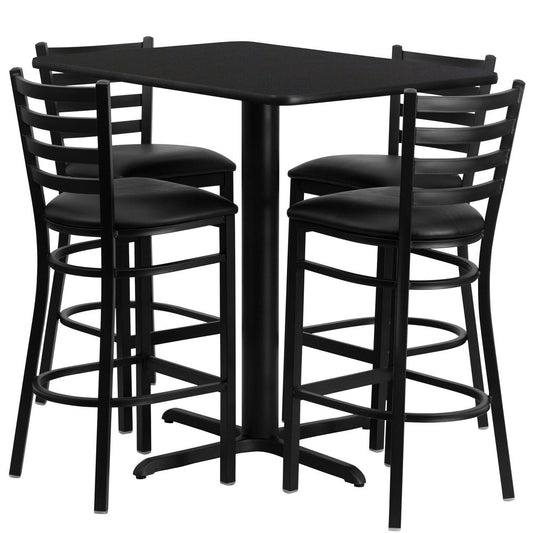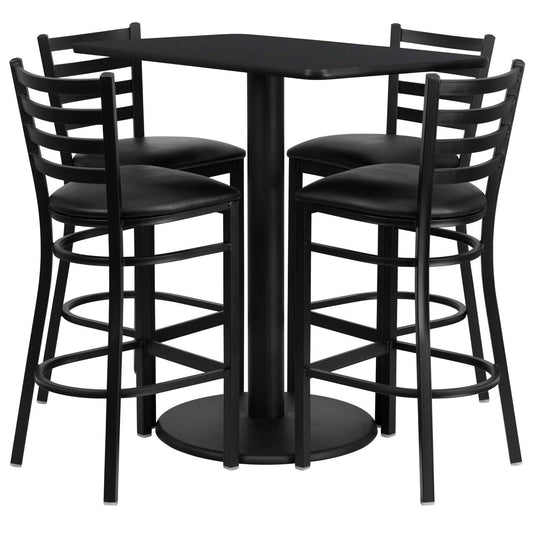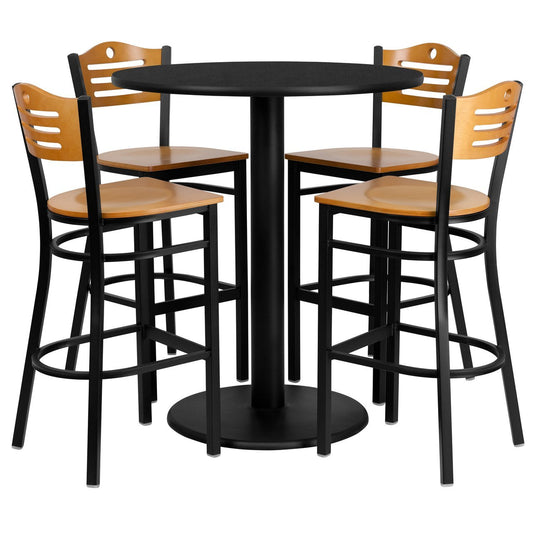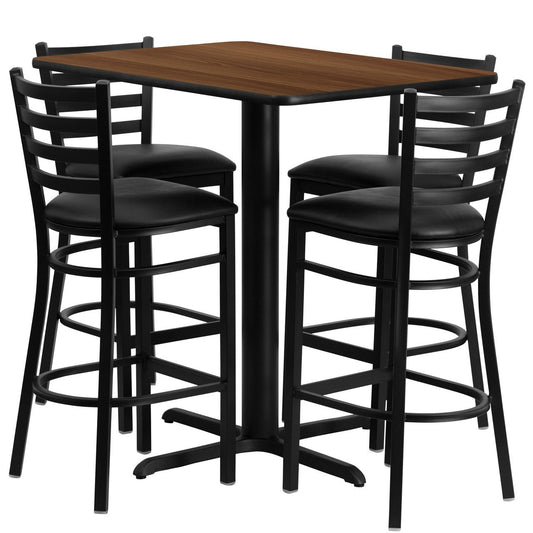
Seating Styles Across the Globe: Bar Heights Explained
Share
Seating is a key part of interior design and helps create a comfortable space for customers, whether it is at home, in a bar, or in a restaurant. Around the world, people always find variations in seating arrangements, but bar stools remain important. The types of bar stools available include a different design, material used in manufacturing, and height; which is one of the most important elements that determine comfort and efficiency.
In this blog, we will learn about different types of seating, define bar stool height, and provide tips on what kind of bar stool is best suited, bar stool seat height, layouts, popular bar height metal stools and bar seating.

What Are the Different Bar Stool Heights?
When selecting the bar stool, the height is very important to ensure that it is comfortable and can be used in the right places. It is worth noting that different facilities may require stools of different heights. Standard bar stool heights are generally divided into three categories:
- Counter Height (24-27 inches): These stools are perfect for counters that are up to 36 inches high. While common bar stool heights range between 28-32 inches, counter-height bar stools are perfect for kitchens, casual dining areas, and home bars. They create a relaxed seating position, which is good for people who want to talk up close.
- Bar Height (28-32 inches): Bar height stools are best used for standard bar tops that are around 40-42 inches in height. These are common in bars, pubs, and restaurants because people enjoy their drink or food and get a higher standpoint.
- Extra Tall Bar Height (33-36 inches): They are ideal for counters or bars that are 44-48 inches high, for example, bar counters. This stool height is quite rare but can be used in some contemporary bars or any place that wants to adopt some sort of casual look.
All of these heights have specific uses and when chosen ensure that guests are comfortable and touching the bar or counter at the correct height.
Bar Stool Seat Height: Ensuring Comfort and Functionality
The primary factor that should be considered when choosing bar stools is the bar stool seat height. When selecting your desired height for the seating, the distances between the edges of the seat and the bottom surface of the counter, or bar, should be approximately 9-12 inches. It also makes provision for enough space to be left between the seats so that the customers do not feel uncomfortable when they sit on the seats.
Seat height can influence the comfort level as well as the total design of your bar depending on your choice. For example, a tall chair with a low table or bar decreases the harmony of a restaurant’s interior and makes the guests uncomfortable. On the other hand, placing stools at a very low level may pose discomfort in this view. People will tend to slump on the stools.
Counter Height Metal Bar Stools: A Blend of Style and Durability
For those who would like to have long-lasting and trendy options, counter-height metal bar stools are ideal. These are stools that have incorporated metallic material with stylish features. Metal stools are ideal for use in establishments where furniture and tables with bar stools are used frequently, as they are made to last despite the wear and tear of everyday use and are sleek enough to fit in today’s bars and cafes.
Bar stools also provide different customization. It is available in a range of finishes from matte black to polished chrome to enable a choice based on the overall theme of the establishment. In addition, most metal stools have backrests with padded seats to provide comfort in height counter and bar height dining solutions.
Global Seating Trends: How Culture Influences Bar Stool Design
Bar stool designs and shapes vary around the world due to cultural preferences, local design trends, and the intended use of the bar stool. For example, the bar stools you will find in most bars in Europe will have a more formal traditional look with wooden frames and upholstered seats. However, the stools available in North America are different as they come in a more traditional look and focus more on design as opposed to materials that use metal and even plastic materials.
First of all, minimalist bar stools characterize the region’s design work, being relatively unpretentious pieces of furniture made of natural materials, such as wood or bamboo. On the other hand, bar stools of a tropical design will depict ivory colors and seats made with plain woven fabrics because of the Caribbean region’s lively and comfortable climatic conditions.
Types of Seating Arrangements for Restaurants and Bars
The placing of chairs and tables within your restaurant or bar will affect many aspects such as traffic patterns, level of social mingling, and type of environment created. Here are some of the common seating styles across different types of establishments:
- Bar Seating: Having stools around the bar provides a place to sit and allows for eating or drinking. It was observed that guests seated at the bar have a lively conversation with the bartender compared to guests seated at tables. Bar seating is good for places where the management wants to get people in a positive or engaging mindset.
- Booth Seating: This provides a fairly secluded dining setting which is good if you don’t want to be around a lot of people. Tables are sometimes arranged along walls where booths are usually arranged and create an intimate setting for small groups or two people. They are especially perfect for restaurants that want to bring a more intimate and friendly atmosphere.
- High Tables with Stools: These create a comfortable and loose structure for seating. Used in sports bars, pubs, and cafes; high tables with bar stools are ideal for a place where people can have a meal or drink comfortably. Such arrangements are perfect for places where the focus is on meetings in a relaxed setting.
- Communal Seating: Many contemporary bars and restaurants are implementing the concept of community tables. These relatively wide tables allow guests to mingle, and these formats are suitable for places where people have to spend time together.
What Is Bar Layout and Design?
The bar layout and design refer to everything concerning the physical setting and organization of your area. It means it defines how your bar functions, how workers and customers navigate the site, and how effectively drink and food can be brought in. Accessibility is achieved through compliant aisle width, maximization of space, and structural design of the building to make customers comfortable and spend more of their time on the premises, ordering more products.
There are several key elements to a good bar layout and design:
- Back Bar Setup: This is a counter at the back of a bar where the bartenders operate. Well–The order back bar allows bartenders to restock imagined beverages so that they can mix the drinks effectively. This area normally entails shelves for bottles, sinks, fridges, and other instrumental equipment.
- Bar Counter Space: Customers will be served at this counter and thus the height, width, and length of the counter influence the factors that make up the counter. A bar counter that is too narrow feels that this place is too narrow to work and on the other hand, if a bar counter is wide it becomes difficult for customers to connect with the person behind the bar counter.
- Service Areas: Service stations should be placed in such a way that they are not congested. The traffic pattern of people in a well-maintained bar divides the bartenders, servers, and customers in such a way that they can continue serving efficiently regardless of the busy periods.
Things to Consider in Bar Design and Layout
When planning the design and layout of a bar, one must consider several important factors to ensure both functionality and aesthetics:
- Space Utilization: When designing your space, you want to ensure that you are making the best use of space without cramming. Specifically, the seating arrangement should permit adequate space between tables and stools to allow access by both patrons and staff.
- Ambiance and Theme: The establishment's furniture, lighting, and colors should fit its overall theme. A modern bar might have shiny metal bar stools that are simply decorated, while a country pub will have wooden bar stools and a dimly lit atmosphere.
- Functionality for Staff: For a bar to operate efficiently the layout must not only suit the consumers, but more so the bar employees. Waiters and bartenders should be able to get access to the bar’s necessary equipment and tools; at the same time servers must find ways to move around the bar without interactions with the customers or other servers.
- Customer Comfort: Comfort is key. Seating should also have good back and cushioning and be designed to be easy to clean as well as for maintenance. The layout for the sitting must ensure that guests have their invisibility without feeling lonely as if they are the only ones in the room.
- Accessibility: Whatever kind of audience you are serving, accessibility should be taken into consideration, especially for those with disabilities. Make sure the store layout—aisles, tables, seating areas, is designed to help those in wheelchairs or using other mobility devices.
Conclusion: Choosing the Perfect Bar Stool for Your Space
Choosing bar stools involves more than just picking the right style or color that fits with your interior design theme. Seating height, the comfort of your seats, and the general design of where you will seat people all play an important role in terms of the usability of the space. Be aware of how bar stool seat height works, learn how to plan a highly functional bar seating system, and consider today's stylish counter height metal bar stools to create a seating layout that not only looks good but also contributes to better use of the bar and your establishment.
Whether you're setting up a bar for a commercial establishment serving customers or updating your restaurant kitchen, the right bar stools will keep your space comfortable, attractive, and long-lasting.




